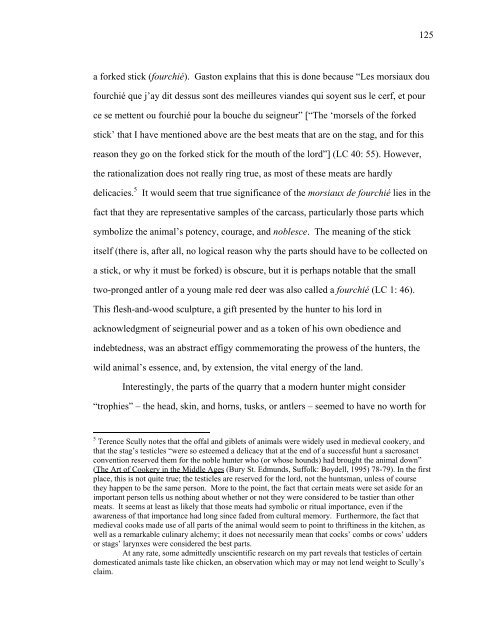Chapter 4 The Gift.pdf - eCommons@Cornell
Chapter 4 The Gift.pdf - eCommons@Cornell
Chapter 4 The Gift.pdf - eCommons@Cornell
Create successful ePaper yourself
Turn your PDF publications into a flip-book with our unique Google optimized e-Paper software.
a forked stick (fourchié). Gaston explains that this is done because “Les morsiaux dou<br />
fourchié que j’ay dit dessus sont des meilleures viandes qui soyent sus le cerf, et pour<br />
ce se mettent ou fourchié pour la bouche du seigneur” [“<strong>The</strong> ‘morsels of the forked<br />
stick’ that I have mentioned above are the best meats that are on the stag, and for this<br />
reason they go on the forked stick for the mouth of the lord”] (LC 40: 55). However,<br />
the rationalization does not really ring true, as most of these meats are hardly<br />
delicacies. 5 It would seem that true significance of the morsiaux de fourchié lies in the<br />
fact that they are representative samples of the carcass, particularly those parts which<br />
symbolize the animal’s potency, courage, and noblesce. <strong>The</strong> meaning of the stick<br />
itself (there is, after all, no logical reason why the parts should have to be collected on<br />
a stick, or why it must be forked) is obscure, but it is perhaps notable that the small<br />
two-pronged antler of a young male red deer was also called a fourchié (LC 1: 46).<br />
This flesh-and-wood sculpture, a gift presented by the hunter to his lord in<br />
acknowledgment of seigneurial power and as a token of his own obedience and<br />
indebtedness, was an abstract effigy commemorating the prowess of the hunters, the<br />
wild animal’s essence, and, by extension, the vital energy of the land.<br />
Interestingly, the parts of the quarry that a modern hunter might consider<br />
“trophies” – the head, skin, and horns, tusks, or antlers – seemed to have no worth for<br />
5 Terence Scully notes that the offal and giblets of animals were widely used in medieval cookery, and<br />
that the stag’s testicles “were so esteemed a delicacy that at the end of a successful hunt a sacrosanct<br />
convention reserved them for the noble hunter who (or whose hounds) had brought the animal down”<br />
(<strong>The</strong> Art of Cookery in the Middle Ages (Bury St. Edmunds, Suffolk: Boydell, 1995) 78-79). In the first<br />
place, this is not quite true; the testicles are reserved for the lord, not the huntsman, unless of course<br />
they happen to be the same person. More to the point, the fact that certain meats were set aside for an<br />
important person tells us nothing about whether or not they were considered to be tastier than other<br />
meats. It seems at least as likely that those meats had symbolic or ritual importance, even if the<br />
awareness of that importance had long since faded from cultural memory. Furthermore, the fact that<br />
medieval cooks made use of all parts of the animal would seem to point to thriftiness in the kitchen, as<br />
well as a remarkable culinary alchemy; it does not necessarily mean that cocks’ combs or cows’ udders<br />
or stags’ larynxes were considered the best parts.<br />
At any rate, some admittedly unscientific research on my part reveals that testicles of certain<br />
domesticated animals taste like chicken, an observation which may or may not lend weight to Scully’s<br />
claim.<br />
125

















